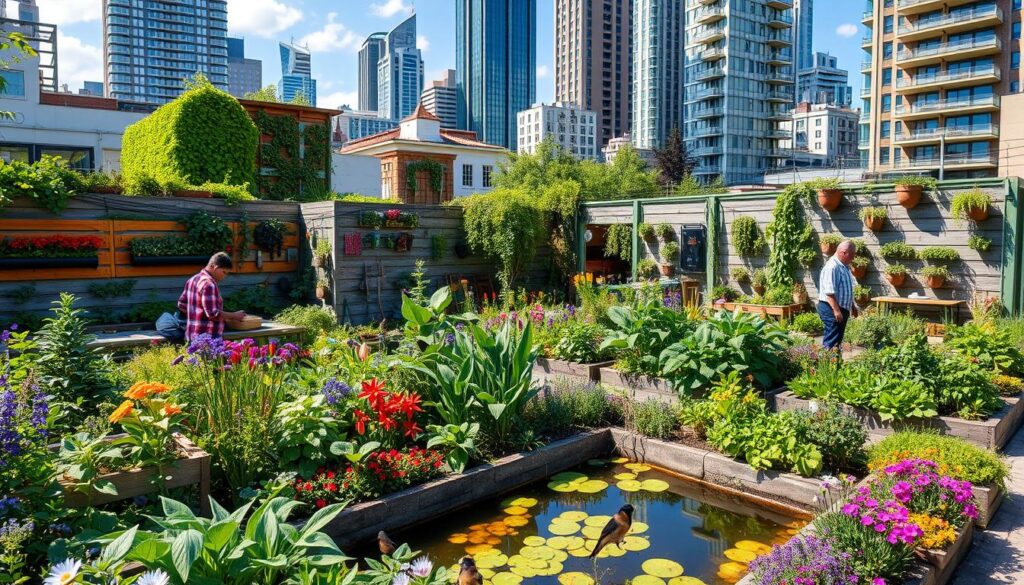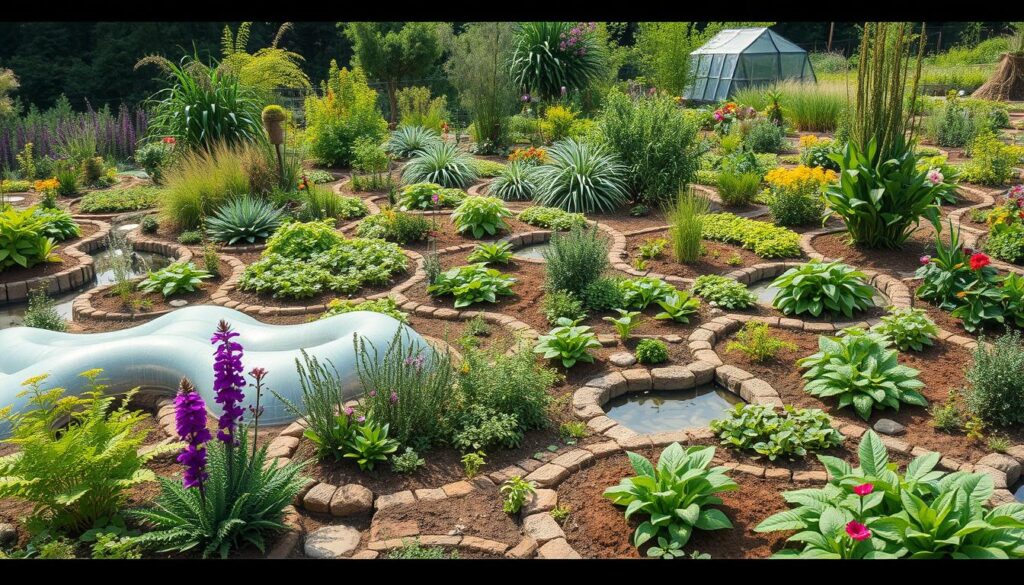In today’s world, 81% of North Americans live in cities without nature. I found a way to heal my mind through permaculture. It showed me how being cut off from nature harms our mental health.
Permaculture is more than gardening. It’s a way to connect with nature’s healing power. Studies show that being in nature can make us stronger and less stressed.
City life keeps us away from nature for too long. We lose touch with the natural world. Permaculture helps us take back our mental space. It turns small areas into green, life-giving places that care for our bodies and minds.
Key Takeaways
- Permaculture provides a holistic approach to mental health restoration
- Urban environments can negatively impact psychological well-being
- Natural landscapes offer significant mental health benefits
- Small-scale ecological design can transform personal spaces
- Reconnecting with nature is crucial for modern mental health
Understanding Permaculture and Its Principles
Permaculture is a new way of living that’s more than just gardening. It’s about creating a sustainable lifestyle. It comes from “permanent agriculture” and “permanent culture,” aiming to make our lives better for the planet.
Permaculture is not just about growing food. It’s a way of thinking that changes how we live with nature.
Definition of Permaculture
Permaculture started in the 1970s with Australian ecologists. It’s a system that uses nature’s patterns to design farms and communities.
Core Principles of Permaculture
- Observe and interact with natural systems
- Catch and store energy effectively
- Obtain a yield through sustainable practices
- Apply self-regulation and accept feedback
- Use and value renewable resources
The Role of Ethics in Permaculture
“Permaculture is a philosophy of working with, rather than against nature, of protracted and thoughtful observation rather than protracted and thoughtless labor.” – Bill Mollison
The ethics of permaculture are key:
- Earth Care: Protecting and regenerating nature
- People Care: Helping human health and well-being
- Fair Share: Sharing resources fairly
By following these principles, we can change our lives. We can build stronger, greener communities and take care of ourselves and the planet.
The Connection Between Nature and Mental Health
Looking into how nature affects our mental health shows us something amazing. It shows us that being in nature is not just nice, but essential for our minds to heal.

Science has found that nature can change our mental state in big ways. It shows how green spaces can help us heal our minds.
How Nature Affects Mental Well-Being
Being in nature has many benefits for our minds:
- It lowers stress hormones
- It makes our brains less active in negative thoughts
- It boosts our mood and helps us control our emotions
- It also improves how well we think
Studies Linking Nature to Reduced Stress
“Nature’s healing power is not mystical, but scientifically verifiable.” – Environmental Psychology Research Group
| Research Finding | Mental Health Impact |
|---|---|
| 90-minute nature walk | Decreased negative brain activity |
| Urban proximity to trees | Reduced antidepressant usage |
| Greenspace exposure | Lower psychosis risk |
Benefits of Green Spaces
Green areas have many benefits for our mental health. Being in nature can lower our stress hormones, lower blood pressure, and help us manage stress. People living in cities who spend time in nature feel better and are more resilient.
Nature’s power to heal goes beyond just helping us feel better. It offers a complete way to heal our minds through wellness permaculture principles.
Creating Permaculture Gardens for Restoration
Permaculture wellness design turns outdoor spaces into healing places. They help both our minds and bodies feel better. Green living design helps us create spaces that heal us and the planet.
Creating a permaculture garden needs careful planning. We aim to make a space that grows food and heals our minds and hearts.
Strategic Garden Design Principles
- Create multiple sensory zones
- Incorporate peaceful seating areas
- Select plants with therapeutic properties
- Design meditative pathways
Plant Selection for Mental Wellness
Choosing the right plants is key for mental health. Lavender, chamomile, and rosemary are great because they calm us down.
| Plant | Mental Health Benefits | Growing Conditions |
|---|---|---|
| Lavender | Reduces anxiety | Full sun, well-drained soil |
| Chamomile | Promotes relaxation | Partial shade, moist soil |
| Rosemary | Improves memory | Full sun, dry conditions |
Incorporating Natural Elements
“A garden is a complex psychological landscape that reflects inner emotional terrain.” – Environmental Psychologist
Adding water features, stone paths, and quiet spots turns gardens into healing zones. These elements are very helpful in busy cities.
By using permaculture wellness design, we can make our own healing spaces. These spaces help our mental health and support living in harmony with nature.
Benefits of Permaculture for Mental Restoration
Permaculture is more than just gardening. It’s a way to connect with nature and improve your mental health. By using earth-conscious design, you can find deep mental peace.

Permaculture helps you feel whole by linking you with nature’s healing power. It’s a complete approach to mental wellness.
Enhancing Mindfulness Through Gardening
Gardening is like meditation, helping you find mental peace. Studies show it can really help reduce stress:
- Cortisol levels can drop by up to 25% with regular gardening
- It can increase daily activity by about 30%
- People feel 60% more satisfied with life
Encouraging Creative Expression
Permaculture gardens are like living art. They let you express your creativity and improve your mental health. You can make a garden that shows your inner world.
“Gardening is a form of creative meditation that nurtures both the earth and the soul.”
Building Community and Support Networks
| Community Impact | Percentage Increase |
|---|---|
| Social Connectivity | 20-50% |
| Project Participation Growth | 20-30% Annually |
| Mental Health Symptom Reduction | 60-80% |
Permaculture projects help build strong communities. They connect people through shared values and growth.
Permaculture is more than gardening. It’s a journey to mental healing and community bonding.
Therapeutic Practices in Permaculture
Permaculture offers a special way to heal and grow by linking us with nature. It helps us find deep healing and personal growth in the natural world.
Today, we see how important nature is for our well-being. Permaculture shows new ways to heal our minds and hearts.
The Concept of Ecotherapy
Ecotherapy mixes healing with nature. It focuses on:
- Connecting with living ecosystems
- Experiencing sensory interactions with nature
- Understanding personal ecological relationships
Grounding Techniques in Nature
Grounding helps us feel connected to nature. Studies show it’s good for our mental health:
| Technique | Mental Health Impact | Stress Reduction |
|---|---|---|
| Barefoot Walking | Reduces Anxiety | 20% Cortisol Decrease |
| Garden Meditation | Improves Mood | 30% Serotonin Increase |
| Soil Interaction | Enhances Emotional Regulation | 25% Stress Reduction |
Engaging the Senses
Designing for holistic health means using all our senses in nature. Intentional sensory engagement changes how we heal.
“Nature itself is the best physician” – Hippocrates
These practices help us bond with ourselves and nature. They lead to better mental health through permaculture.
Case Studies: Successful Permaculture Initiatives
Permaculture projects worldwide are changing urban areas and boosting mental health. They show how eco-friendly living can improve community well-being.

Urban permaculture is solving mental health issues and environmental problems. Cities are being transformed by green spaces. These spaces help people connect and heal.
Urban Permaculture Projects: Global Innovations
- Hong Kong has developed over 60 rooftop farms since 2015
- Thammasat University in Bangkok created Asia’s largest organic rooftop farm spanning 20,000 square meters
- A rooftop garden in Bethlehem’s Aida refugee camp has benefited over 2,000 people
Community Gardens and Mental Health Impact
Research shows urban green spaces greatly improve mental health. Gardens can lower stress and boost well-being.
“Permaculture is not just about growing food, but cultivating community and personal resilience.” – Permaculture Pioneer
| Location | Project Highlight | Community Impact |
|---|---|---|
| Montreal | Rooftop Greenhouse | Produces 11,000 kg food weekly |
| Brussels | Lagum Project | Generated 2 tonnes of produce |
| Johannesburg | Rooftop Hops Garden | Quarterly crop rotation |
School Programs Incorporating Permaculture
Schools are now teaching permaculture to promote sustainability and mental health. These programs give students practical skills and teach them to care for the environment.
The permaculture movement started in 1978 by Bill Mollison and David Holmgren. It inspires new ways to live sustainably, focusing on both people and the planet.
The Role of Permaculture in Sustainable Living
Permaculture is a new way to make our environments sustainable. It helps both people and nature. This approach brings us closer to our surroundings.
Permaculture is more than just gardening. It creates full ecosystems that help both people and the planet. It’s a powerful way to solve environmental problems and make communities stronger.
Permaculture’s Impact on Local Ecosystems
Permaculture makes ecosystems healthier through smart design. It brings many benefits, like:
- Increased biodiversity
- Soil regeneration
- Reduced environmental degradation
- Enhanced pollination opportunities
Creating a Self-Sustaining Environment
Communities can make regenerative landscapes with permaculture. These landscapes grow food and need less outside help. Studies show they can produce 20% more than regular farms.
“Permaculture is not just about gardening; it’s about creating living, breathing ecosystems that support life in all its complexity.” – Sustainable Design Expert
Economic Benefits for Communities
Permaculture helps communities financially, too. It brings:
- Lower food production costs
- More local food security
- Less water and energy use
- Stronger community resilience
Community gardens using permaculture have seen big gains. They’ve boosted local food production by 33%. They also give fresh food to city folks.
Overcoming Challenges in Permaculture Practices
Starting a permaculture wellness design journey can seem daunting. It needs patience, knowledge, and careful planning. Knowing the common hurdles helps you find ways to succeed.

- Limited garden or outdoor space
- Lack of practical gardening knowledge
- Time constraints
- Financial limitations
- Climate and environmental restrictions
Navigating Initial Obstacles
Overcoming these challenges requires creative thinking. Green living design is about making the most of what you have. Here are some practical tips:
- Start small with container gardens or vertical growing systems
- Join local permaculture communities for support and education
- Utilize online learning resources and workshops
- Develop a phased implementation strategy
“The journey of a thousand miles begins with one small garden bed.” – Permaculture Wisdom
Resources for New Practitioners
There are many resources to help you on your permaculture wellness design journey. Local agricultural extensions, online forums, and workshops offer valuable advice. They help beginners turn their spaces into sustainable ecosystems.
By knowing the challenges and preparing well, you can successfully apply permaculture principles. This way, you create resilient and caring environments.
The Influence of Climate on Permaculture Design
Permaculture design is a powerful way to create wellness solutions that fit different environments. It connects climate and ecosystem design. This helps support both people and the planet.
Climate is key in permaculture. It shapes how we design sustainable landscapes. Each area has its own challenges and chances for growth.
Adapting Permaculture to Diverse Climatic Conditions
For permaculture to work, we must think about local conditions. Important steps include:
- Looking at local rain patterns
- Checking the soil
- Knowing the temperature range
- Examining small climate changes
Resilient Plant Selection for Regional Ecosystems
Picking the right plants is vital for a thriving permaculture. We aim for plants that not only survive but also help the ecosystem.
| Climate Zone | Recommended Plant Types | Key Adaptation Characteristics |
|---|---|---|
| Arid Regions | Succulents, Drought-Resistant Herbs | Water Conservation, Deep Root Systems |
| Temperate Zones | Fruit Trees, Perennial Vegetables | Seasonal Adaptability, Diverse Yields |
| Tropical Regions | Banana, Cassava, Diverse Legumes | High Biomass Production, Rapid Growth |
“In permaculture, we work with nature, not against it.” – Bill Mollison
By using climate-specific design, permaculture helps both nature and people. Knowing local ecosystems leads to better, lasting landscape care.
Community Involvement in Permaculture Initiatives
Permaculture mental restoration grows when we connect with others. Strong local networks turn solo gardening into a team effort. This supports both mental health and green living.
Communities are key in spreading permaculture ideas. Working together opens doors for learning, support, and growth.
Building Local Networks
Strong community ties are vital for permaculture success. Here are some ways to build them:
- Organize neighborhood gardening workshops
- Host community skill-sharing events
- Start local permaculture study groups
- Create shared garden spaces
Volunteer Opportunities in Permaculture Projects
“Community involvement transforms individual efforts into collective healing.” – Permaculture Design Expert
Volunteering is a great way to help yourself and others. Local permaculture projects need help in many ways:
- Help with community garden upkeep
- Assist with educational programs
- Join in ecosystem restoration efforts
- Help with sustainable living workshops
By joining permaculture projects, you help your mental health, strengthen your community, and support green living.
Tools and Techniques for Permaculture Success
Permaculture is a way to garden that’s good for the planet. It turns gardening into a lifestyle that’s kind to the earth. Learning the right tools and methods helps gardeners make spaces that are both strong and fruitful.
Essential Gardening Tools for Holistic Landscape Management
Good permaculture gardeners know that the right tools are key. They use tools that are gentle on the environment but still get the job done well. The permaculture design approach is all about using tools that are both effective and eco-friendly.
- Hand pruners for precise plant maintenance
- Broad fork for soil aeration without disruption
- Compost thermometer for monitoring decomposition
- Rain barrels for water conservation
- Soil testing kits for nutrient analysis
Innovative Gardening Techniques in Permaculture
Permaculture needs new ways of gardening to thrive. These methods are different from regular gardening. They work with nature, not against it.
| Technique | Benefits |
|---|---|
| Sheet Mulching | Reduces weeding by 80%, improves soil structure |
| Companion Planting | Increases biodiversity, natural pest control |
| Swale Construction | Manages water flow, prevents erosion |
| Chicken Tractor Systems | Natural pest control, soil fertilization |
“In permaculture, every element serves multiple functions, transforming challenges into opportunities.” – Bill Mollison
By using these tools and methods, gardeners can make spaces that are good for the earth and for themselves.
Mental Restoration Techniques in Permaculture
Permaculture offers a special way to heal your mind through gardening. A well-designed garden becomes a safe space for growth and healing. It’s not just about growing food; it’s about finding peace and understanding yourself.
Practicing Mindfulness in the Garden
Gardening can be a form of meditation if you do it with purpose. Mindful gardening means using all your senses and living in the moment. It helps clear your mind by:
- Doing tasks slowly and carefully
- Practicing deep breathing
- Noticing small changes in plants
- Listening to nature’s sounds
“The garden suggests there might be a place where we can meet nature halfway.” – Michael Pollan
The Benefits of Journaling Your Gardening Journey
Writing down your gardening experiences can greatly improve your mental health. By keeping a journal, you can track your growth and learn about nature. It’s a powerful tool for personal growth and understanding the environment.
Journaling has many benefits for your mind:
- It helps you see how far you’ve come and what you’ve learned
- It lets you process your feelings about gardening
- It helps you appreciate nature’s cycles more
- It creates a lasting record of your journey
By using these techniques, gardening becomes more than just growing plants. It becomes a way to take care of your mind and connect with nature.
Educating Others on Permaculture and Mental Health
Sharing knowledge about permaculture wellness design is key for community empowerment and mental health awareness. Teaching others transforms individual knowledge into collective action. This creates strong opportunities for green living design.
Effective education needs strategic approaches to engage and inspire communities. Experts in permaculture have come up with new ways to share insights on sustainable living and mental restoration.
Workshops and Classes for Community Engagement
Community workshops offer practical ways to learn about permaculture. Successful educational strategies include:
- Interactive learning sessions
- Hands-on gardening demonstrations
- Mental health connection presentations
- Collaborative design exercises
“Education is the most powerful weapon which you can use to change the world.” – Rosemary Morrow, Permaculture Educator
Sharing Resources and Research
Spreading knowledge needs comprehensive resource sharing. Experts suggest the following:
| Resource Type | Distribution Method | Target Audience |
|---|---|---|
| Educational Guides | Online Platforms | General Public |
| Research Papers | Academic Journals | Researchers |
| Teaching Materials | Certification Programs | Aspiring Educators |
The Permaculture Educators Program supports global efforts to train teachers. It spreads sustainable design knowledge, focusing on mental health benefits and community resilience.
Future Trends in Permaculture and Mental Restoration
Permaculture is changing how we think about mental health and caring for the Earth. It’s a new way to connect our well-being with nature. This approach is becoming more popular as people want to live in harmony with the planet.
Permaculture is becoming a big deal in the wellness world. More people see how important it is to take care of our minds and the Earth together. They’re finding that living sustainably helps our mental health.
Emerging Trends in Permaculture
- Integration of mental health programs with ecological design
- Community-based regenerative wellness solutions
- Expansion of earth-conscious design in therapeutic settings
Innovative Approaches to Mental Health
Permaculture is leading the way in new mental health methods. It uses nature to help people feel better. This approach is changing how we think about healing.
| Program Type | Mental Health Benefits | Community Impact |
|---|---|---|
| Urban Permaculture Therapy | Stress Reduction | Increased Social Connectivity |
| Ecological Mindfulness Programs | Anxiety Management | Environmental Awareness |
| Community Garden Interventions | Emotional Resilience | Local Empowerment |
“Permaculture offers more than agricultural design—it’s a pathway to healing both individuals and ecosystems.” – Ecological Wellness Expert
Future Vision for Mental Restoration
The future of mental health is linked to caring for the Earth. By using permaculture, we can create better ways to heal our minds and the planet. This approach helps both people and nature thrive.
Studies show that nature is key to our mental health. Permaculture is leading a movement to heal us in a more natural way. It’s about finding compassion and balance in our lives and the world around us.
Resources for Further Learning about Permaculture
Learning about permaculture is a journey that never ends. It starts with finding good resources to learn and grow. These resources help you understand and apply sustainable living practices.
Permaculture has a lot to teach us through many learning platforms. Whether you’re new or experienced, these resources can improve your skills and knowledge.
Essential Books and Publications
Reading the right books can change how you see permaculture and mental health. Some key books include:
- “Permaculture One” by David Holmgren and Bill Mollison – a classic from 1978
- “Gaia’s Garden” by Toby Hemenway
- “Sustainable Mental Health Through Permaculture” by modern authors
Online Courses and Workshops
Online learning has made permaculture education easy to access from anywhere:
| Platform | Course Type | Focus Area |
|---|---|---|
| Permaculture Design Academy | Comprehensive Online Course | Design & Mental Restoration |
| Holmgren Design Services | Specialized Workshops | Sustainable Living Practices |
| Regenerative Leadership Institute | Certification Programs | Ecological Design |
“Learning is the beginning of transformation in permaculture and personal growth.” – David Holmgren
Your journey to learn about permaculture mental restoration is ongoing. It involves exploring, learning, and growing. These resources are a great start to deepen your knowledge and practice.
Conclusion: The Holistic Benefits of Permaculture
Permaculture is more than just farming. It’s a way to live in harmony with nature. Since the 1970s, Bill Mollison and David Holmgren have shown its power. It changes how we live and feel, making our lives better.
Permaculture helps our minds and builds strong communities. Urban gardens, for example, cut down on industrial food needs. They also create places where people can come together. These gardens boost biodiversity and make our ecosystems stronger.
Summary of Key Points
Permaculture has many benefits. It saves water and cuts down on harmful chemicals. Its three main ethics guide us to care for the Earth, ourselves, and share fairly. It helps us connect with nature and improve our surroundings.
Encouragement to Explore Permaculture for Mental Restoration
Starting your journey to better mental health is easy. Just take a step into permaculture. You can start small, join community projects, or learn more. Every action helps create a healthier world.

